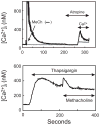Origins of the concept of store-operated calcium entry
- PMID: 21622247
- PMCID: PMC3931420
- DOI: 10.2741/202
Origins of the concept of store-operated calcium entry
Abstract
The concept of capacitative or store-operated calcium entry, a process by which the release of stored calcium signals the opening of plasma membrane calcium channels, has its roots in the late 1970's, and was formalized in 1986. This short introduction to the current volume of Frontiers in Bioscience briefly summarizes the early experimental work that led to the idea of store-operated calcium entry, and provided the initial proofs for it.
Figures



Similar articles
-
Store-operated calcium entry: a tough nut to CRAC.Sci STKE. 2004 Jul 20;2004(243):pe38. doi: 10.1126/stke.2432004pe38. Sci STKE. 2004. PMID: 15280580 Review.
-
Introduction.Adv Exp Med Biol. 2017;993:3-13. doi: 10.1007/978-3-319-57732-6_1. Adv Exp Med Biol. 2017. PMID: 28900906 Review.
-
What role for store-operated Ca²⁺ entry in muscle?Microcirculation. 2013 May;20(4):330-6. doi: 10.1111/micc.12042. Microcirculation. 2013. PMID: 23312019 Free PMC article. Review.
-
The relative contributions of store-operated and voltage-gated Ca2+ channels to the control of Ca2+ oscillations in airway smooth muscle.J Physiol. 2017 May 15;595(10):3129-3141. doi: 10.1113/JP272996. Epub 2016 Sep 21. J Physiol. 2017. PMID: 27502470 Free PMC article.
-
Calcium influx mechanisms underlying calcium oscillations in rat hepatocytes.Hepatology. 2008 Oct;48(4):1273-81. doi: 10.1002/hep.22461. Hepatology. 2008. PMID: 18802964 Free PMC article.
Cited by
-
Generation and characterization of a lysosomally targeted, genetically encoded Ca(2+)-sensor.Biochem J. 2013 Jan 15;449(2):449-57. doi: 10.1042/BJ20120898. Biochem J. 2013. PMID: 23098255 Free PMC article.
-
Effects of calreticulin deficiency and myeloproliferative neoplasm (MPN)-linked mutation on cellular calcium signaling.bioRxiv [Preprint]. 2025 Jun 27:2025.06.25.661618. doi: 10.1101/2025.06.25.661618. bioRxiv. 2025. PMID: 40667107 Free PMC article. Preprint.
-
Studies on the resolution of subcellular free calcium concentrations: a technological advance. Focus on "detection of differentially regulated subsarcolemmal calcium signals activated by vasoactive agonists in rat pulmonary artery smooth muscle cells".Am J Physiol Cell Physiol. 2014 Apr 1;306(7):C636-8. doi: 10.1152/ajpcell.00046.2014. Epub 2014 Feb 19. Am J Physiol Cell Physiol. 2014. PMID: 24553184 Free PMC article. No abstract available.
-
Transient receptor potential channels and regulation of lung endothelial permeability.Pulm Circ. 2013 Dec;3(4):802-15. doi: 10.1086/674765. Pulm Circ. 2013. PMID: 25006396 Free PMC article. Review.
-
Long-Term Exercise Reduces Formation of Tubular Aggregates and Promotes Maintenance of Ca2+ Entry Units in Aged Muscle.Front Physiol. 2021 Jan 5;11:601057. doi: 10.3389/fphys.2020.601057. eCollection 2020. Front Physiol. 2021. PMID: 33469430 Free PMC article.
References
-
- Putney JW. A model for receptor-regulated calcium entry. Cell Calcium. 1986;7:1–12. - PubMed
-
- Bohr DF. Vascular smooth muscle updated. Circulation Research. 1973;32:665–672. - PubMed
-
- Douglas WW. Involvement of calcium in exocytosis and the exocytosis vesiculation sequence. Biochemical Society Symposia. 1974;39:1–28. - PubMed
-
- Marty A. Control of ionic currents and fluid secretion by muscarinic agonists in exocrine glands. Trends in Neurosciences. 1987;10:373–377.
Publication types
MeSH terms
Substances
Grants and funding
LinkOut - more resources
Full Text Sources
Other Literature Sources

